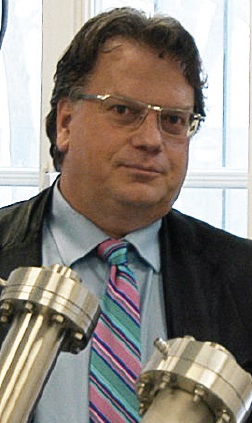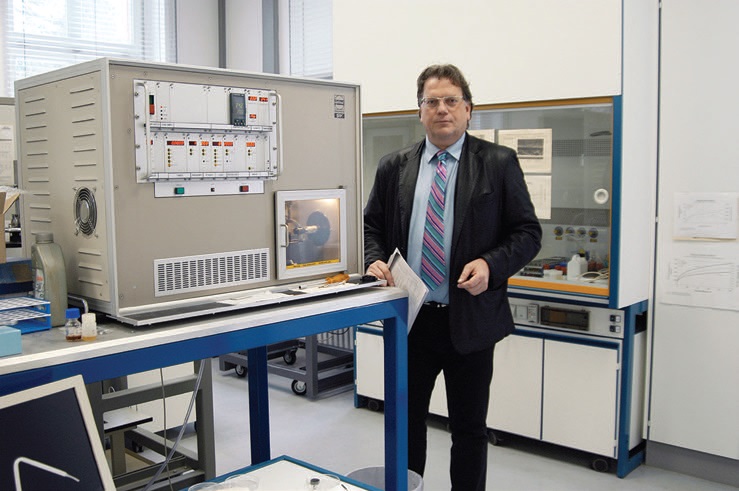20 Minutes With Dr. Mathias Woydt
Thomas T. Astrene, Publisher | TLT 20 Minutes March 2011
This Berlin-based researcher explains why PAGs for automobile engine oils are closer to becoming a reality.
MATHIAS WOYDT - The Quick File
Work Experience
Currently head of the working group Friction and Wear Test Methods-Component Tribology at BAM Federal Institute for Materials Research and Testing, Berlin, Germany. Has held other research and lab positions with BAM and also has served as an assistant professor at the Technical University of Berlin in Germany.
Education
Doctorate in Materials Science – Technical University of Berlin – 1989 (
graduated cum laude)
Master’s of Materials Science – Technical University of Berlin – 1986 (
graduated summa cum laude)
Honors & Accomplishments
Patent applications: 45
Published articles: More than 200
Conference papers: More than 150
Conference chairs: More than 120
Technical committee chairs: 10
Assessor: Assessor of DAP German Accreditation System for special test methods for petroleum products.
 Dr. Mathias Woydt
Dr. Mathias Woydt
TLT: For more than 10 years you have conducted extensive research into alternative engine oils based on polyglycols as potential replacements for hydrocarbon oils. What inspired you to conduct this research?
Woydt: For many years there has been interest in developing alternative engine oils to those based on hydrocarbon oils, particularly since the mid-1930s when several synthetic chemistries such as synthetic esters and polyalkylene glycols (PAGs) appeared.
Historically, engine oils based on esters or polyglycols are not new. They were used in the past in extreme applications where hydrocarbon-based oils didn’t meet the more stringent specifications. This was particularly evident in World War II when synthetic lubricants were introduced by the U.S. Air Force and the German Luftwaffe.
For example, in P-38s, P-47s, P-51s und B-25s, the U.S. Air Force used polyglycols from Union Carbide to avoid soot deposits in the oil cooler and because they offered much better low-temperature properties than mineral oils, thereby providing enhanced protection and operability in cold climates. The German Luftwaffe used in all engines a blend of ß-methyladipic acid ester with a Fischer-Tropsch polyethylene oil for resource shortage, soot control and because these also had good low-temperature properties.
Polyalkylene glycols were pioneered by the Union Carbide Corp. in the 1940s. initially they attracted interest as viscosity builders of water-based, fi re-resistant hydraulic fluids. They became the only major lubricant base oil that offers water solubility, which is a unique benefit still offered today.
PAGs in the 1950s were evaluated as synthetic engine oils to provide better engine wear protection. PAGs were known to have excellent film-forming properties due to the oxygen-rich nature of the polymers. Formulators and oems continued to experiment with PAGs during the 1960s and 1970s, but there were no significant breakthroughs as base fluids in automotive engine oils despite the fundamental properties of PAGs showing superior performance than hydrocarbon oils. even the french car maker Renault in 1973 was close to introducing a polypropylene glycol-based engine oil.
My interest in PAGs began in 1993 where I worked on a project with Daimler looking for an oil-free engine in terms of having a deficient lubrication of the tribosystems in engines beared by roller bearings. “Oil free” also meant using alternative oils to mineral oils. The lubes should have been delivered periodically to the tribosystem and would have been consumed there. This was a kind of one-way lubrication because the engine had no oil pan and oil circuit. Unadditivated PAGs were a candidate because a key requirement was for the oil to be biodegradable. Due to a high amount of ceramic components used in the engine, this approach was discontinued.
In 1998 Renault had a plan to develop an environmental and maintenance-free vehicle. It was built and presented as the demonstrator ELLYPSS at the Autosalon de Paris in the fall of 2002. Long drains up to 100,000 km for a passenger car and excellent “bio-no-tox” properties were the targets. Bio-no-tox means biodegradable and non-toxic to aquatic environments. At that time, esters were a preferred choice since they offer greater oxidation resistance.
Since 2002 more than four European and national projects, with the participation of RENAULT and FIAT, were started to understand the fundamental tribology aspects of PAGs by developing structure property relationships. In addition, formulation knowledge is being developed since the additive packages designed to perform well in hydrocarbon oils are not tailored for PAGs.
One important benefit of PAG-based engine oils is that conceptually one may be able to use much lower treat levels of additives and also eliminate certain additive types such as viscosity index improvers. For example, PAGs have much higher viscosity index values than hydrocarbon oils and, hence, do not require the high level of viscosity improvers found in mineral oils. In addition, for some applications, it may be possible to use formulations that do not contain detergents and dispersants.
The technical literature reports thermolysis for polyglycols, and that’s why they are unsuited as engine or jet turbine oils. our understanding of the reaction steps during oxidation is clear, and the polyglycol-based formulations meet the targets formulated in the ELLYPSE project. In other words, they exceed what’s needed today for the European market. In Renault’s case, the actual polyglycol-based engine oil formulations exceed Class 3, indicating a drain interval of >30,000 km in turbodiesel passenger cars with particulate filter. Keep in mind that modifications of the base oils, including new processes, contributed to the improvements in oxidation resistance.
We have actual data from road and engine bench testing confirming the much extended drain intervals. many different automotive OEMs experienced something they hadn't believed before in that the viscosmetrics of polyglycols are stable over extended drains, and the drained fluids remained basically clear.
This practical observation is coherent with the experience reported by the U.S. Air Force during the end of WW II and was published in American journals at that time.
 In World War II synthetic lubricants were introduced by the U.S. Air Force and the German Luftwaffe.
In World War II synthetic lubricants were introduced by the U.S. Air Force and the German Luftwaffe.
www.canstockphoto.com
TLT: What are potential limitations of hydrocarbon oils, and why do you believe new fluid concepts and solutions are needed?
Woydt: Macrotrends in the industry include fuel economy improvements and exhaust gas emission reduction as well as retention of the oil’s rheology and tribology properties over extended drain intervals.
Fuel economy can be achieved by using lower-viscosity oils with high-temperature high-shear (HTHS) values below 2.6 mPas and through the oil having high viscosity indices (above 200). Polyglycols can offer both through their intrinsic properties. This has the further benefit that the formulations do not need additional polymers as viscosity modifiers, which often are shear unstable.
In additional, NOACK-evaporation losses are typically 50% lower than those achievable by using hydrocarbon-based engine oils. An added bonus is that most fully-formulated PAGs offer excellent bio-no-tox properties, a benefit to consumers in the future and for the image of companies.
The fully-formulated polyglycol engine oils that have been developed in collaboration with Dow Chemical also are metal- and ash-free. This can eliminate the increase in exhaust back pressure while retaining fuel economy because the pores are not blocked by ash. Second, the active centers of the catalytic convertors should not be contaminated and rendered less efficient by zinc, molybdenum salts and ash.
There are also other important benefits of PAGs, like increased heat capacity.
 Mathias Woydt has held several technical positions with BAM Federal Institute for Materials Research and Testing in Berlin, Germany.
TLT: You have extensively researched new environmentally friendly polyalkylene glycols. What is special about these fluids for current and future engine oil requirements?
Mathias Woydt has held several technical positions with BAM Federal Institute for Materials Research and Testing in Berlin, Germany.
TLT: You have extensively researched new environmentally friendly polyalkylene glycols. What is special about these fluids for current and future engine oil requirements?
Woydt: They allow reduced HTHS figures but give the same or better wear protection. Automotive OEMs argue about too low HTHS; some see >2.6 mPa, others >3.0 mPas and still others >3.5 mPas.
In the last four years of development, no single engine has failed using polyglycols. The recent discussion around the SAE grades underlines the need for low-viscosity engine oils, which can be intrinsically fulfilled by polyglycols. Low-viscosity polyglycols with a HTHS below 2.6 mPas offer NOACK evaporation combined with Vis above 200.
For example, an oil-tolerant polyglycol-based and polymer- free formulation with a HTHS of -2.15 mPas, a Vi of 205, and a NOACK of 5.8% is not so bad and difficult to reach with hydrocarbon-based formulations.
TLT: What interest do automotive OEMs have for new and novel lubricant solutions such as PAGs?
Woydt: Automotive OEMs are challenged with meeting the fuel economy targets set by carbon tax regulations. I believe that by using synthetic PAG engine oils, this can be accomplished in a very cost-effective way.
For example, the average CO
2 emission target on vehicles in EU in 2009 was 146 gram CO
2/km. By using PAGs, we believe a 4% in fuel economy savings is possible, which equates to ~ 6 gram of CO
2/km. This can allow for significant savings to automotive OEMs that are taxed based on their CO
2 emissions per vehicle.
The operators of large fleets see here an improvement in the carbon footprint. The additional costs for the polyglycol fluids are much lower, especially when compared to costs of lightweight car body engineering. Recent road tests indicate we will be able to also extend the drains, which represents another benefit for fleet operators.
TLT: What benefits have OEMs seen with PAGs?
Woydt: Simply this: fuel economy, extended drain intervals and longer life of exhaust after-treatment devices.
TLT: Are there recent field experiences using PAGs as automotive engine oils?
Woydt: In recent years I have worked with Dow Chemical and many European and North American OEMs to validate that synthetic PAG lubricants can solve many of today’s challenges in terms of fuel economy improvements, emission reduction and wear protection. Specific OEM bench-tests and small vehicle trials have provided a solid scientific basis that validates their performance.
The next part of the overall technology program is to leverage this to long-term vehicle trials. After more than 17 years of researching the intrinsic benefits of PAGs for engine oils, we are now much closer to commercial reality.
TLT: If there were an industry change to PAGs, is there a sufficient manufacturing infrastructure in place to supply these products?
Woydt: It is likely that synthetic engine oils based on PAGs will occupy a niche segment of the total market for the next decade. However, one can envision a possibility where the benefits of PAGs are universally accepted and a broader adoption across the industry is taken. This may mean new alkoxylation capacity is needed.
However, for the foreseeable future there is significant infrastructure in place and large-scale process knowledge to provide the industry with product. Many major chemical companies have assets capable of producing PAGs. Alkoxylation today encompasses many industries and affects such products as lubricants, polyurethane foams and surfactants, where significantly more volume is consumed vs. alkoxylates used in the lubricant industry.
The closest competitor of polyglycols are esters. The total production volume of polyglycols is at least 10 times higher than for esters. Some plants synthesize polyglycols in a scale of >30,000 metric tons per year. The actual production capacities for ethylene oxide range from about >22 million tons and those for propylene oxide above 4 million tons.
TLT: If new and novel lubricants such as PAGs are used in place of hydrocarbon oils, will engine designs need to change?
Woydt: Engine designs will not change, although we’ll need substitutes for some minor plastics. Design engineers fully understand that they can get more benefits from polyglycols by revisiting the design, because the rheology of a more or less Newtonian fluid differs from fluids presenting shear losses or pseudo-plastic behaviors.
The higher heat capacity in J/(cm³K) has an impact on fuel economy because the flow rate of the oil pump can be lowered. Also, it is easier to assure the thermal balance in highly downsized engines.
You can reach Dr. Mathias Woydt at mathias.woydt@bam.de.